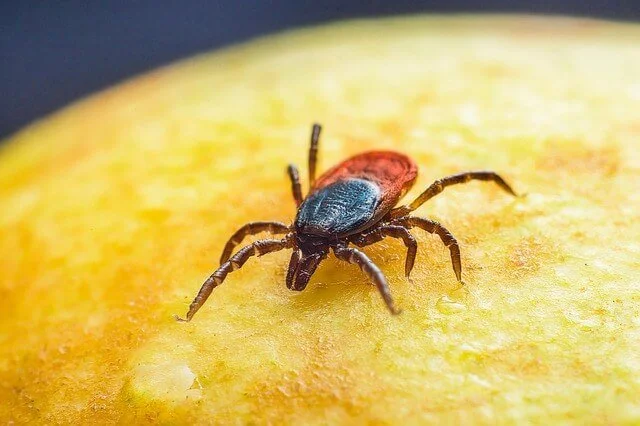What To Do If Your Dog Gets A Tick
In This Article
Paralysis ticks are one of the biggest dangers to dogs in Brisbane and South East Queensland. They love our humid weather, and are most commonly found in bush areas.
Peak season is spring and summer (September to March) but they're active all year round in SEQ. And they're no joke. Ticks are deadly if not caught early. Ticks are responsible for more pet deaths in our region than snakes and spiders combined 😵💫
This guide covers what to do if you find a tick on your dog, from safe removal to recovery. This is practical guidance from a canine nutritionist: always contact your vet if you have any concerns about tick paralysis.
How To Identify A Tick
Paralysis ticks are small grey or blue creatures with 8 legs. As they feed they swell up and can look like a grey/blue grape or wart. Size ranges from a pinhead (when hungry) to about 1cm (when full). You can see legs that are visible near the head when you look closely.
Ticks love warm hidden spots on your dog. The only way to find them is to give your dog a thorough inspection. During tick season it's a good idea to check your dog every day - especially after walks.
To do this, run your fingers thoroughly through their entire coat feeling for small bumps. The key is to use your fingertips, not just your eyes. If you feel anything at all, even if you think it's a wart or bump, give it a closer look. Check around the head, face and ears, and especially inside & behind the ears. The neck and chest area are the hot spots, but also look between toes and on feet or legs, under the collar and around the tail & rear end.
Symptoms Of Tick Bite
Ticks inject a neurotoxin as they feed. Symptoms can appear 3 to 7 days after attachment, but the toxin can continue to affect your dog for 24 to 48 hours even after you remove the tick. Smaller dogs and puppies are particularly vulnerable and symptoms progress faster in them.
Watch for these signs:
weakness in the back legs
wobbly or unsteady walk
change in bark or voice (sounds different or weaker)
difficulty swallowing
excessive drooling
vomiting or regurgitation
coughing or difficulty breathing
lethargy or unusual tiredness
rapid breathing or panting
How To Remove A Tick Safely
If you find a tick on your dog, don't panic! If you feel confident that you can remove the tick cleanly it's a good idea to do that immediately. But either way, you need to go to the emergency vet ASAP.
To remove the tick you'll need a tick removal tool (available from pet stores) or some fine-tipped tweezers. Grab some gloves if you have them, and a container with a lid to save the tick. A magnifying glass can be helpful too.
Here's the process: Quick and careful removal is important, and so is staying calm. Part the fur around the tick so that you can see it clearly. Position the tick tool as close to the skin as possible. You want to grab the head, not the body. Twist or gently lever the tick - don't pull straight up. Apply steady even pressure until the tick releases. Then check that you've removed the whole tick including the head. Put the tick in a sealed container because your vet may want to see it to confirm it's a paralysis tick. And lastly, clean the bite area with antiseptic if you have it.
What not to do: Don't squeeze or crush the tick's body because this injects more toxin. Don't use chemicals, methylated spirits, or petroleum jelly. Don't twist or pull it out aggressively. And don't delay. Remove it as soon as you find it if you feel you can do so cleanly.
OK the tick is out. Now it's time to go to the vet - immediately.
Your vet will do a full physical examination and thorough tick search. They'll check for more ticks because often there can be more than one. They'll assess symptoms and toxin progression, and decide if tick antitoxin is needed.
Hospitalisation for monitoring is typical, usually 24 to 72 hours depending on severity. Some dogs need intensive care with breathing support. Your vet will advise when it's safe to take your dog home and what to watch for during recovery.
Supporting Recovery At Home
Once you bring your dog home from the vet, they will be quite weak. It's good idea to rest them for at least 2 to 3 weeks while they recover. Avoid walks, running, or excited play. Keep them in a cool, calm environment because excitement or exertion can trigger symptom relapse.
A properly formulated raw food diet is the best way to support your dog's recovery. Raw food provides bioavailable nutrients, enzymes, and amino acids that support healing. It's easy to digest, which reduces stress on a compromised system.
Beyond diet, be sure to keep fresh water available at all times. Some dogs may have difficulty drinking if swallowing is affected, so watch that they're actually drinking adequate amounts. Obviously, contact your vet if they're not drinking properly.
Continue watching for any breathing changes, weakness or wobbliness, vomiting or regurgitation, and changes to their bark or voice. Changes can indicate ongoing issues. The 48 hour period after tick removal is most critical, but some dogs take 2 to 3 weeks to fully recover.
Prevention: A Complex Decision
The more difficult aspect of ticks is prevention. This is one of the most difficult decisions dog owners in SEQ face and there's no perfect solution. Every option involves a trade-off. Chemical products are generally highly effective but also can have life threatening side effects. Natural options are generally safe but can be significantly less effective.
What to do?! 🤨
Your individual situation matters enormously. Proximity to bush and lifestyle are big factors, because they change the likelihood that your dog will get a tick in the first place. If your dog is in the bush regularly, it massively increase the risk of getting a tick.
Your vet will be recommending chemical prevention options like Bravecto, NexGard, and Simparica, which belong to the isoxazoline class of drugs. They're highly effective at killing ticks and fleas - they work.
They also cause serious side effects.
The FDA has issued warnings about potential neurologic adverse events including seizures, tremors, and ataxia in dogs and cats treated with isoxazoline products. Common side effects include vomiting, diarrhoea, decreased appetite, lethargy, and in rare cases, neurological symptoms like seizures.
The reported adverse reactions are pretty extensive. Browse Bravecto Facebook groups and you'll see countless reports of severe reactions and deaths. The reality is that these products are poison. Effective poison! But poison nonetheless.
Alternatively, there are many natural prevention options on the market including essential oil blends, diatomaceous earth, neem oil, and herbal collars. I wish I could tell you these are 100% effective but I haven't seen enough evidence that they are. They may offer some level of protection but personally I wouldn't rely on them in high risk tick areas.
What Do We Do?
We lived near the bush when Nelly was young and found a tick on her. It was absolutely terrifying and we nearly lost her. Our vet scared us into using Bravecto and we used it while living in that high risk area. Nelly didn't have any immediate adverse reactions thankfully, but who knows what harm it did to her. We still feel horrible about it.
When we moved away from the bush, we decided we didn't want to poison her to keep ticks at bay. So we now rely on daily tick checks. This works for us because we're no longer in a high risk bush area and Nelly is older now so she's less active than she used to be. It's not ideal, but it's the compromise we're comfortable with.
Plus, she really loves the attention!
The most important prevention strategy, regardless of what else you choose, is daily tick checks. Run your hands over your entire dog every single day. Check thoroughly after any time in bush areas or long grass. The sooner you find and remove a tick, the better. Most paralysis tick toxin is injected after 3 or more days of attachment.
Make it part of your routine, like brushing teeth. This is non-negotiable if you're not using chemical prevention.
Either way you choose, there's no judgement from us. Ticks are no joke and if you are in a high risk environment maybe the drugs are worth while. It's a genuinely difficult decision with no good answer. Good luck! 🐾






